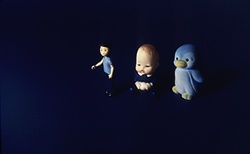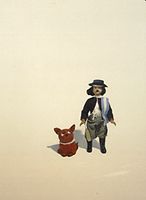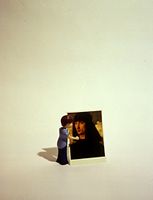The
quoted "wor(l)d" of Liliana Porter
By
Fernando Castro R.
 |
|
The
ligth 1997
|
P hotography has been the central vehicle of Liliana Porter's work since 1995. She often photographs staged plastic or porcelain mass-produced figurines of political, religious or comic-book characters. On occasion the figurines are paired so that the viewer is enticed to imagine a dialogue between them. What can Pinocchio be telling Gregorio Hernandez, the Venezuelan popular saint? Who is lying to whom? Moreover, when Porter transgresses the flat medium of photography and incorporates assemblages of objects, the characters seem to be talking across a dimensional or ontological divide -maybe even about it. Their muted conversations cannot be directly quoted, not only because they are not spelled out but also because perhaps they are meant to remain as questions or mental tickles in the psyche of the viewer.
Two important critics, Gerardo Mosquera and Luis Camnitzer, have interpreted Liliana Porter's recent photographic work by alluding to the literary work of Jorge Luis Borges and the painterly work of René Magritte. Porter's interest in Magritte is no secret; she has quoted him in works like "Magritte's 16th of September" (1975), "The Great War" (1975), "La Luna" (1977) and more recently, in "La Clairvoyance" (1999). Given that Borges' works are not visual, their relationship to Porter's oeuvre must be, therefore, necessarily conceptual. Although in 1983 she produced the work "Fragments with Borges' Book," representing a sample of a book is not tantamount to representing the literary work in the book, whereas representing a painting is representing the painterly work. In spite of the clues in Porter's works that sustain the interpretations of Mosquera and Camnitzer, it seems counterintuitive that her photographs of kitschy porcelain figurines could fit in the aesthetic horizon of one of the most cerebral writers of all times, or even of Magritte's brand of surrealism. Mosquera himself readily acknowledges that "In her mixture and appropriation of appropriations, Porter has put Lichtenstein's comics or Haring's Mickey next to the 'real' Mickey." The task at hand is therefore to understand how Porter's work, whose iconic antecedents are clearly found in Pop Art, somehow manages to subvert it.
Referring to Porter's work since 1995, Mosquera has written that it "is a New York setting on images of Jorge Luis Borges," clarifying that he is "not referring to a thematic or formal intertextuality but to one of sense." To be sure, Mosquera's analysis is much more intricate than we can sketch here, but the Cuban critic understands that "Porter's work has been defined in terms of its subversion of the frontiers between reality and virtuality, the original and the copy, as well as the sense and the status of things." A work like "Dressed Penguin" (1996) -which depicts a figurative dialogue between the photographic image of a clay figurine of an anthropomorphized penguin and the real figurine of a yellow bird sitting on a little stool- does indeed show some of the subversive traits Mosquera mentions. He connects this "anti-taxonomic" penchant in Porter's work with Borges' "Chinese Encyclopedia." The latter spells out an unlikely although possible alternative classification of animals that comically undermines Linnaeus' more entrenched one. Similarly, Porter subverts the genres of representation. Her figurines are already representations, her photographs are representations of representations, and the assemblages are a symbiosis of the former and the latter which forms a set as arbitrary as Borges' category of animals that "can be drawn with a fine brush."
 |
|
Gaucho
1995
|
Camnitzer's use of Borges for interpreting Porter's work seems more tangential and is not independent of his view of Magritte's work. Also referring to her work since 1995, Camnitzer writes that "Porter decided to confront reality more directly, either by using the objects themselves or through photography as a means to document them. (....) What could have been included as visual accompaniment in a book by Borges or Lewis Carroll -her favorite literary models- now began to turn into her own book." In this process, "what was refined was the quality of the dialogue of her objects. It was literally a question of establishing what things one object had to say to another and/or to the viewer." Camnitzer's main analogy of Porter's works with Magritte's oeuvre is that what one figurine could be saying to the other is established in such a way as when in Magritte's works "one image turns into the context of the other." Although Camnitzer does not mention specific works by Magritte, one could perhaps propose "The Empire of Light" (1952), where a daytime sky renders unlikely a perfectly plausible nocturnal street scene, or the paradoxical "Ceci n'est pas une pomme" (1964), where the text in the painting truthfully denies what the picture verily depicts.
According to Camnitzer, for Magritte as well as for Porter, "it does matter who the characters are.(....) Porter's art does not work with just any object. Her selection is careful and reflects not only the world delineated by Borges, by Alice in Wonderland, and by Magritte, but also by her very personal blend of astonishment, childishness, and humorous distancing." Unfortunately, Camnitzer only mentions two items from Borges' literary repertoire, and it is not clear how they are reflected in Porter's selection of figurines. One of the chosen items is the Aleph, the extraordinary sphere containing all other points in the universe; and the other is one of the protagonists of the story El Aleph, Carlos Argentino Daneri, who sets out to write a poem about every place on this planet. Nothing of the sort appears in Porter's work ---not even by analogy. Giving Camnitzer massive amounts of foreign aid, one might point out that the split between Borges the author and Borges the character in his dialogue with Carlos Argentino in some relevant way resembles those imagined dialogues between Porter's figurines. That suggestion may be interesting enough, but how can a written dialogue resemble an imagined one? My question is not rhetorical but sincere.
Mosquera's use of Magritte in interpreting Porter's work is more radical. He views Porter as "...Magritte's natural continuator, as she keeps the playful nature, as opposed to the conceptual theoreticism of other territories spelled out by him." According to Mosquera, "by creating new objects that can in turn be linguistically questioned, [Porter] plays with the irony that the work of the Belgian artist goes on to be part of the reality that he is questioning." However, "there is a typical tone in her work that mixes humor and cynicism with a loving warmth." In "La Clairvoyance" (1999), Porter introduces Magritte into her work made up of an actual stone and a postcard of a painting of Magritte as he synechdochically paints an egg as a bird. An implication is that Porter has represented (if her act may be thus called) an egg-like stone as this postcard and/or this postcard as an egg-like stone. Such are the ways of symbolization, as arbitrary as Borges' animal classification in his Chinese Encyclopedia. Is that Encyclopedia also alluded to in "Dialogue in Chinese" (1998)?
 |
|
Boy
with postcard 1998
|
In spite of the obvious parallels to Borges and Magritte brought out more or less successfully by Camnitzer and Mosquera, Porter may be doing something that is substantially simpler. She is letting her characters have the life that their iconic personalities have determined for them. This strategy may lead to all sorts of results depending upon the character and the mix of media. In cases of mixed media (photograph/assemblage) the dialogue of two characters might be imagined to be about their ontological predicaments. Like the Square talking to the Sphere about their kinds of existence in Edwin Abbott's Flatland. At other times there may not even be a suggestion of a dialogue. Porter's triptych "Untitled out of focus Che" (1991-1995) has received surprisingly little attention by the above-mentioned critics. The work shows a plate with Alberto Korda's famous image of Che Guevara, the Communist revolutionist, and a figurine of Mickey Mouse. In the early seventies, a book by Ariel Dorfman called Para leer al Pato Donald (To Read Donald Duck) accompanied and fueled the controversy about cultural alienation in Latin America. One of the issues of the controversy had to do with the way the values of capitalism were inculcated in the minds of the young, through comic book characters like Mickey Mouse, Donald Duck, etc. Porter's triptych conflates by means of the blurriness of an out-of-focus photograph two characters that somehow symbolized the two opposing sides of that controversy. The out-of-focus technique, however, puts both Mickey and Che on the same plane, rendering them both agents of ideological penetration. There is no dialogue between the two characters -only the noisy silence of icons.
In spite of the resemblance of Porter's work to Pop Art works like that of Jeff Koons, Keith Haring and Roy Lichtenstein, her innocent images do indeed enter speculatively into the fields of ontology and the paradoxes of representation. At any rate, it is precisely the issues, puzzles, and paradoxes of representation that Borges, Magritte and Porter have in common. That realization notwithstanding, it is clear that Porter gives her viewers and characters free will so that the viewer him/herself can fill in the space between the quotation marks of the characters' dialogue, in spite of Borges, in spite of Magritte and in spite of Porter herself.
Fernando Castro R.
You may contact Fernando Castro R. at: eusebio9@earthlink.ne
BIBLIOGRAPHY
Abbott, Edwin: Flatland. New York: Dover Publications, Inc., 1952.
Borges, Jorge Luis: El Aleph. Buenos Aires: Emece Editores, 1973.
Borges, Jorge Luis: Selected Non-Fiction. New York: Viking Penguin,
1999.
Camnitzer, Luis: "The Poetry of Communication," in Art Nexus.
Bogotá: #35 Feb-Apr 2000.
Dorfman, Ariel / Mattelart, Armand: Para leer al Pato Donald. Valparaiso:
Ediciones Universitarias, 1973.
Mosquera, Gerardo: "Liliana Porter: Shaking Hands with Mickey,"
in Liliana Porter. New York: Foundation for the Arts, 1996.
Rene Magritte. Ontario: Van Nostrand Reinhold Ltd., 1972.